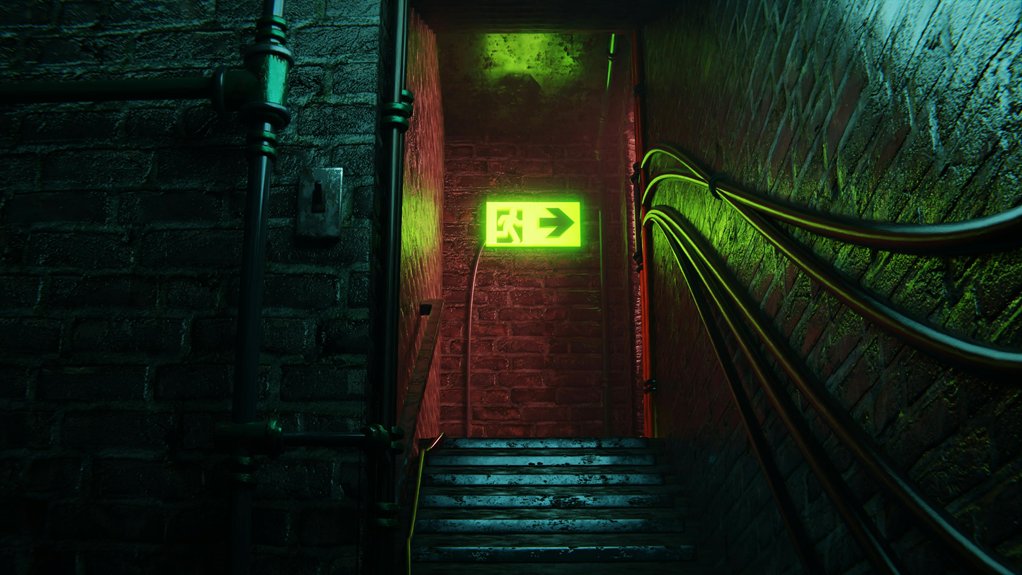When it comes to maintaining your home in Blue Springs, you might overlook your basement until issues arise. Musty odors, water stains, and visible mold can indicate serious moisture problems lurking below. Additionally, cracks in foundation walls and high humidity levels should raise red flags. If you’ve noticed an increase in energy bills, it may be tied to these hidden issues. What other signs should you be on the lookout for?
Key Takeaways
- Musty odors in the basement indicate moisture issues that can lead to mold growth and require immediate attention.
- Water stains on walls and floors suggest moisture intrusion, needing prompt detection and repair to prevent further damage.
- Visible mold and mildew growth signal a damp environment, which poses health risks and necessitates immediate mold remediation.
- Cracks in foundation walls may indicate structural problems, making it essential to schedule a professional inspection for proper assessment and repair.
- Increased energy bills can be a sign of excessive humidity, impacting HVAC efficiency and highlighting the need for basement waterproofing solutions.
Musty Odors in the Basement
When you step into your basement and encounter a musty odor, it’s not just an unpleasant surprise; it often indicates underlying moisture issues.
Poor basement ventilation can trap humidity, creating a breeding ground for mold and mildew. These odor sources thrive in damp conditions, leading to that characteristic smell.
Inspect your basement for signs of moisture intrusion, such as leaks or condensation, which can worsen air quality.
Improving ventilation by adding exhaust fans or dehumidifiers can help mitigate odors and prevent future problems.
Addressing these issues promptly not only enhances comfort but also protects your home’s structural integrity.
Water Stains on Walls and Floors
Water stains on walls and floors are often a clear signal that moisture is making its way into your basement. These stains may indicate significant water damage, especially if they appear frequently or grow larger over time.
It’s essential to address these issues promptly, as persistent moisture can lead to structural problems. Use moisture detection methods to identify sources of water infiltration, like leaky pipes or groundwater seepage.
Don’t ignore these signs; they can escalate into costly repairs. By recognizing water stains early, you can take action to protect your home and maintain a dry, safe environment in your basement.
Visible Mold and Mildew Growth
After noticing water stains on your walls and floors, the appearance of visible mold and mildew growth is another alarming sign of moisture issues in your basement.
Mold thrives in damp environments, and its presence can lead to serious health problems. You should implement mold prevention strategies like improving ventilation, using dehumidifiers, and sealing cracks.
For immediate concerns, mildew treatment options include specialized sprays and cleaning solutions to eliminate the spores.
Ignoring this issue can cause more extensive damage and costly repairs, so addressing mold and mildew promptly is essential for maintaining a safe and healthy basement environment.
Cracks in Foundation Walls
Cracks in foundation walls can signal serious structural problems that may jeopardize the integrity of your home. If you notice these cracks, it’s vital to schedule a foundation inspection promptly.
Ignoring them can lead to worsening damage and costly repairs down the line. During the inspection, professionals will assess the cracks’ size and location to determine their cause.
Based on their findings, they may recommend crack repair solutions, such as epoxy injections or wall anchors, to stabilize your foundation. Addressing these issues early can prevent further complications and guarantee your home remains safe and structurally sound.
Excessive Humidity Levels
If you notice musty odors or see condensation forming on surfaces, it’s likely a sign of excessive humidity in your basement.
High humidity levels not only create an uncomfortable environment but also pose health risks like mold growth and respiratory issues.
Addressing this moisture is vital, and there are effective solutions available to help you maintain a healthier space.
Symptoms of High Humidity
Have you noticed a sticky feeling in the air or a persistent mustiness in your basement? These are common symptoms of high humidity levels.
When humidity spikes, it creates an environment ripe for mold and mildew, signaling that your humidity control measures may be failing. You might also see condensation on windows or walls, indicating excessive moisture.
Check for water stains or peeling paint—these are clear signs that moisture barriers are compromised. If you’re experiencing these issues, it’s essential to address them promptly to prevent further damage and maintain a healthy, dry basement.
Don’t wait; take action now!
Health Risks Involved
While you might appreciate a warm and humid day outside, excessive humidity levels in your basement can pose serious health risks. Mold exposure thrives in such conditions, leading to respiratory issues for you and your family. The spores released can trigger allergies, asthma attacks, and other health complications.
| Health Risk | Description |
|---|---|
| Mold Exposure | Can lead to allergic reactions |
| Respiratory Issues | Aggravates asthma and other conditions |
| Dust Mites | Thrive in humid environments |
| Structural Damage | Compromises air quality |
Addressing these risks is essential for a safe living environment.
Solutions for Excess Moisture
Excessive humidity levels in your basement can lead to serious health concerns, making it imperative to implement effective solutions for managing moisture.
Start by installing moisture barriers, which prevent water vapor from seeping through walls and floors. These barriers are essential in keeping your space dry and reducing humidity.
Additionally, consider drainage solutions like sump pumps and French drains to direct water away from your basement.
Proper ventilation also plays a fundamental role; use dehumidifiers to maintain ideal humidity levels and guarantee air circulation.
Pooling Water or Puddles
If you notice water pooling or forming puddles in your basement, it’s essential to assess the situation immediately.
This accumulation often points to underlying issues related to seasonal rain impacts or an ineffective drainage system.
Addressing these concerns promptly can prevent more significant damage and guarantee your space remains dry and safe.
Water Accumulation Areas
When you notice water pooling in specific areas around your basement, it’s crucial to take action, as this can indicate underlying issues with your waterproofing system.
Identifying these water accumulation areas helps prevent further damage. Here are key considerations:
- Check for poor soil grading – Confirm the ground slopes away from your foundation.
- Look for drainage improvements – Inspect gutters and downspouts for blockages.
- Assess landscaping – Verify plants and features aren’t directing water toward your basement.
- Monitor moisture levels – Use a moisture meter to detect hidden issues.
Addressing these factors can greatly enhance your basement’s waterproofing.
Seasonal Rain Impact
Seasonal rain can greatly exacerbate existing waterproofing challenges in your basement, especially when water pools or forms puddles in unexpected areas. This pooling can lead to significant moisture management issues, fostering mold growth and structural damage. Identifying these puddles early is essential to preventing more extensive problems.
| Signs of Pooling Water | Action Needed |
|---|---|
| Visible puddles | Assess drainage systems |
| Musty odors | Check for leaks |
| Damp walls | Inspect waterproofing |
| Mold growth | Consider professional help |
Addressing these signs promptly can safeguard your home against the impacts of seasonal rainfall.
Drainage System Efficiency
A well-functioning drainage system is essential for preventing pooling water and puddles in your basement. If you notice these issues, it’s time to evaluate your system and consider drainage improvement techniques.
Here are four signs that indicate you may need sump pump installation or other enhancements:
- Water accumulation in corners or along walls.
- Frequent dampness or musty odors in the basement.
- Mold growth or water stains on walls.
- Ineffective gutters that overflow during rain.
Addressing these concerns promptly can prevent costly damage and guarantee your basement remains dry and comfortable.
Don’t wait until it’s too late!
Increased Energy Bills
If you’ve noticed a spike in your energy bills, it might signal more than just rising utility rates; it could indicate underlying moisture problems in your basement.
Excess moisture can lead to poor energy efficiency, as your HVAC system struggles to maintain a comfortable temperature. This increased workload drives up your costs.
Conducting a cost analysis on your energy usage may reveal that addressing basement moisture issues could save you money long-term.
Ignoring these signs can result in higher bills and potential damage to your home, making it essential to contemplate basement waterproofing as a proactive solution.
Conclusion
If you’re noticing any of these signs in your basement, it’s essential to take action. Addressing musty odors, water stains, and visible mold can prevent more significant damage and costly repairs down the line. Don’t ignore cracks in your foundation or excessive humidity; these issues can compromise your home’s structural integrity. By investing in basement waterproofing, you’re not just protecting your property—you’re enhancing its value and ensuring a healthier living environment for you and your family.

